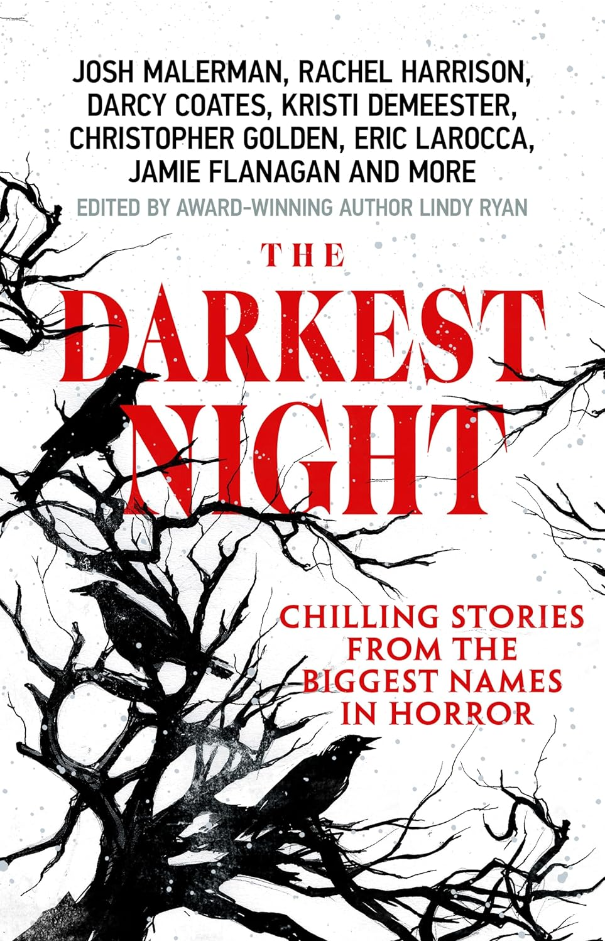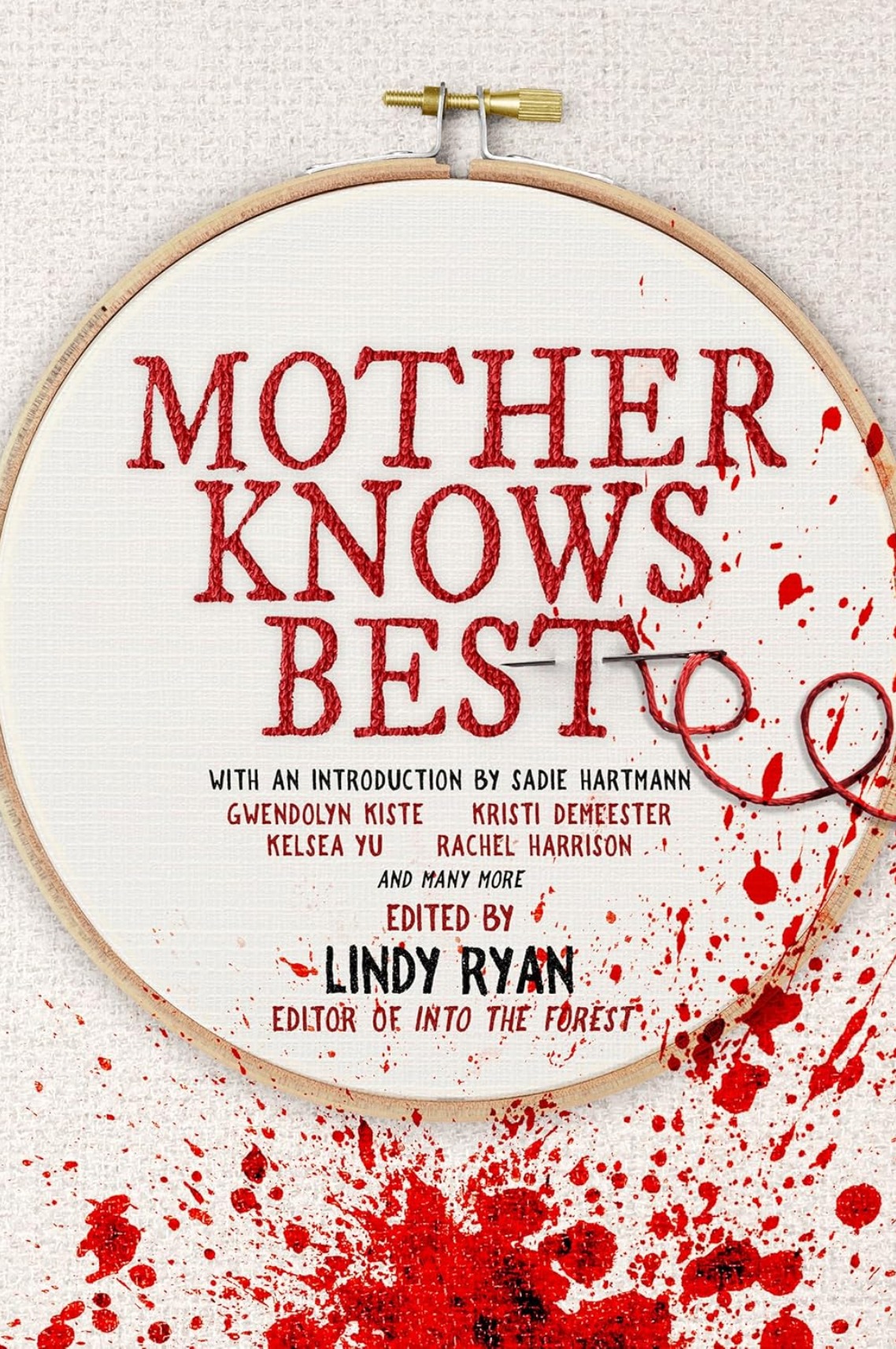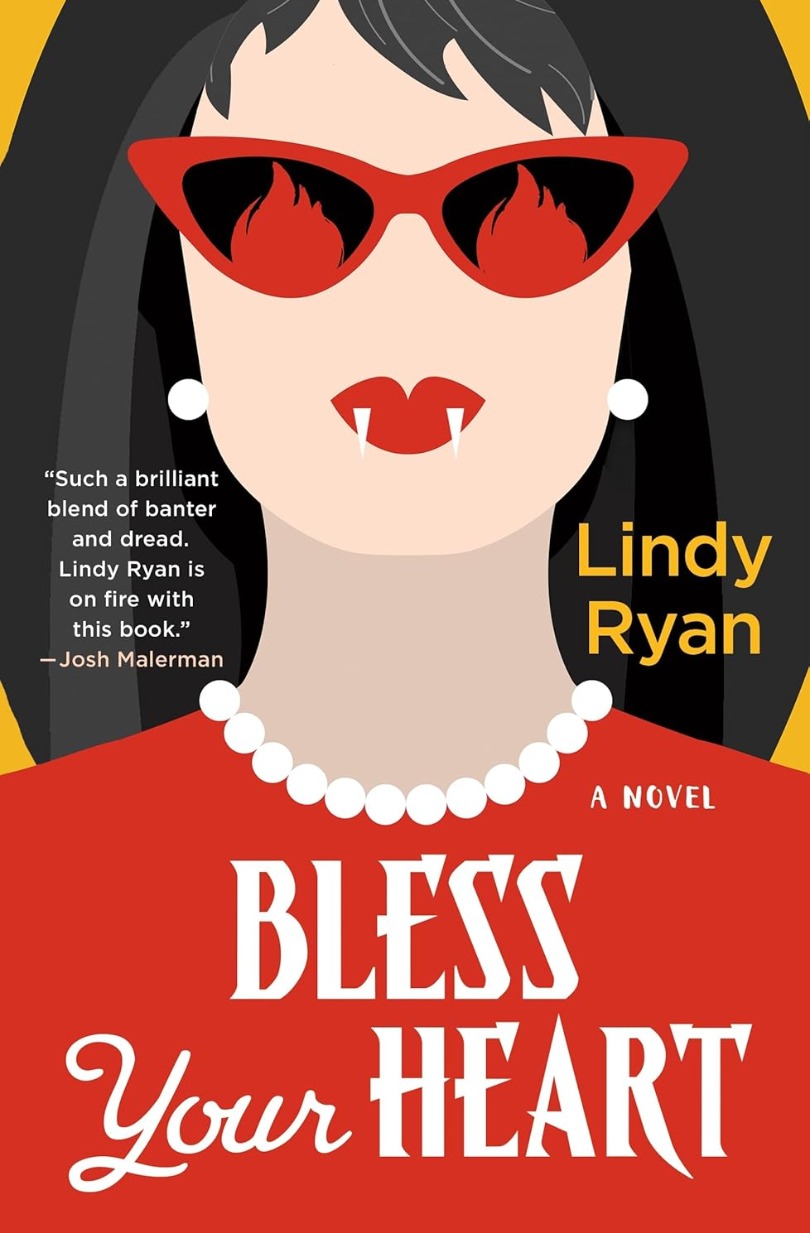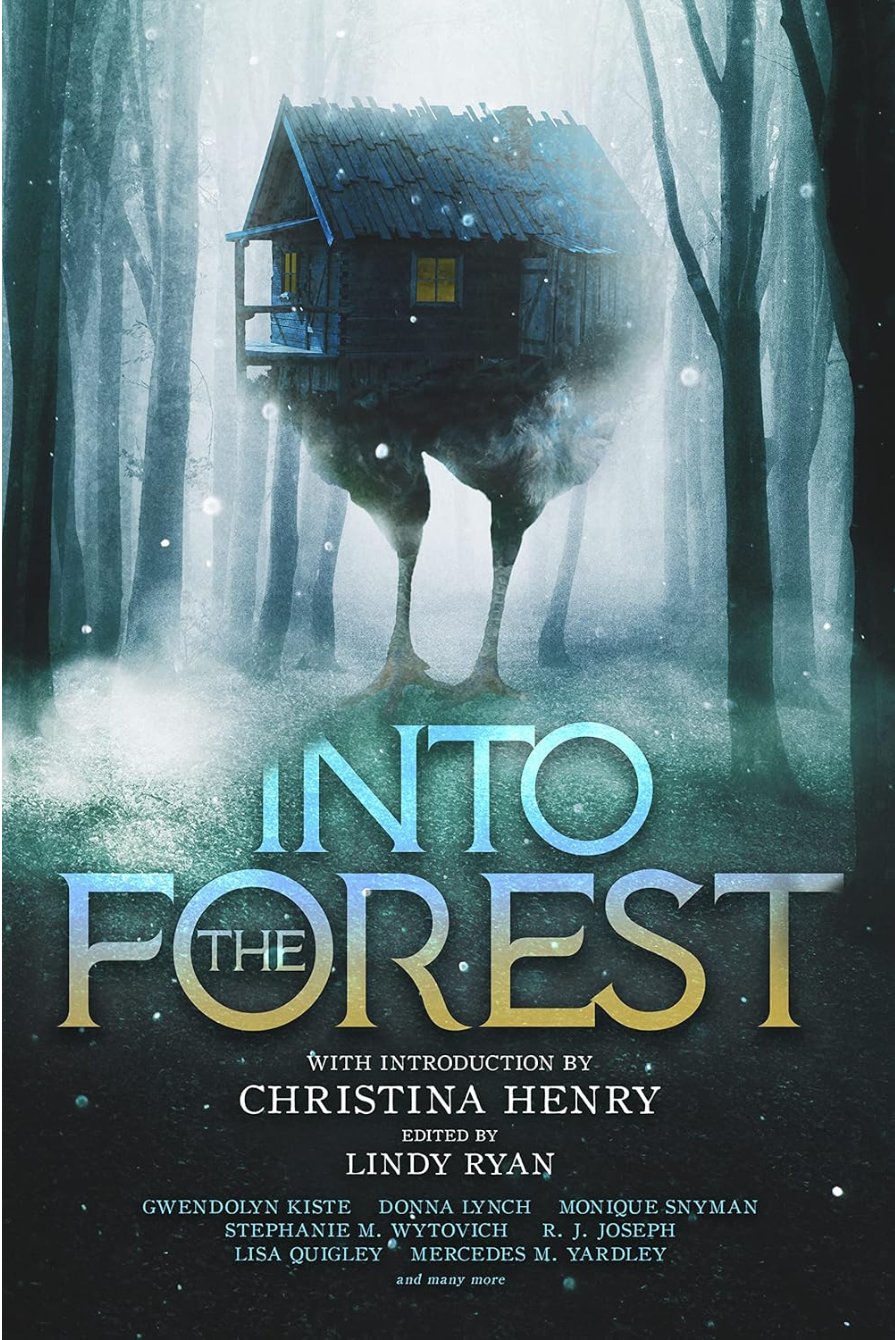Winter and horror go together almost as well as Halloween does with terror. When we think of winter weather, we think of long, stormy nights, blizzards, and lots and lots of snow. All these conditions are conducive to strange things lurking just beyond our field of clear sight. Winter is also the Christmas season, and horror writers have long engaged in effective counterprogramming as we enjoy the seasonal festivities. Thus, we have the legend of Krampus. Lindy Ryan has produced a seasonal anthology, The Darkest Night, containing 22 tales of chilling (pun intended) horror in winter. As in any anthology of this nature, readers get a few lumps of coal. However, most of the tales will earn a high ranking on readers’ scary lists.
About half the stories in The Darkest Night are Christmas-themed, and several other tales feature stormy nights and barely seen people or creatures in the snow and ice. Those that don’t tap into either of these themes are often the weaker entries in the anthology. Although the editor undoubtedly had many classic winter horror stories she could have included, these 22 tales were all newly written for this collection. In considering what to include here, Lindy Ryan has a relatively broad definition of
“horror.” However, I won’t quibble about including a comic or fantasy tale here that’s entertaining but not strictly horror.
Several of the anthology’s Christmas stories are among my favorites. Two involve the traditional “naughty or nice” lists, and they feature different comic styles. In “Nice,” by Nat Cassidy, a lazy elf named Twinklebottom tells a six-year-old boy that the large number of children on the nice list is having terrible repercussions in terms of stressful working conditions at the North Pole. He suggests young Mitchell “not be nice” (quoting Patrick Swayze in Road House). Twinklebottom thinks his scheme will mean less work for him this season. However, the result is a classic case of unforeseen circumstances. The narrator in Jeff Strand’s “Being Nice” is a 17-year-old who just got a lump of coal from Santa for not doing enough nice things to make the nice list in his last year of childhood eligibility. He tries to change his rating by doing enough nice things before Santa completes his yearly rounds. However, the narrator finds it tough to do nice things while wandering the neighborhood at 3:00 a.m. on Christmas morning. The humor here is broader than in “Being Nice” but equally effective.
Another Christmas staple is the holiday party. The protagonist in “Eggnog” by Kristi deMeester is a new mother coping with the stress of motherhood while trying to survive her husband’s office party. Unfortunately, she winds up next to her husband’s gorgeous co-worker, who does not try to disguise her desire to get closer to hubby on business trips. The wife’s scheme to get even is one I’ve never encountered before in decades of reading similar stories. Josh Malerman’s “Children Aren’t the Only Ones Who Know Where the Presents Are Hidden” looks at another Christmas “tradition,” kids’ annual search for gifts their parents have stashed away. The protagonist of this story had an experience so bad that she’s hated all holidays ever since. Here, the finale takes place in the least likely Christmas locale, the Nevada desert near Las Vegas. This story is just as chilling as the more familiar snowbound tales, though. The most bizarre Christmas story is Clay McLeod Chapman’s “Mr. Butler.” The title character here is an empty box (I’m not kidding). This box originally housed a Black & Decker microwave that the protagonist Albee’s abusive stepfather gave his wife as a Christmas present decades earlier. Mr. Butler became the “personification” of all that was bad in the family relationship back then. The box now shows up on the adult Albee’s doorstep, giving him a fresh wave of bad old memories. This story could easily have been ridiculous, but the author makes it plausible (within the fantasy horror realm).
Things that go bump in the night are another common theme in The Darkest Night. In “Thaw” by Rachel Harrison, a couple goes on a winter weekend getaway in the country. However, an uninvited guest “shows up.” The woman sees a snowman, complete with a red scarf and top hat, in the distance. As the night goes on, the snowman keeps reappearing, ever closer to the cabin. It’s a familiar horror trope, but one the author handles very well. “Candy Cane” by Thommy Hutson is another example of a mysterious visitor on a winter night, but the story owes a great debt to Stephen King’s Misery. The year is 1974, and a best-selling horror author who specializes in detailed novels from a serial killer’s perspective gets a knock on his cabin door from a man who claims his car broke down. (Non-spoiler: it didn’t.) Instead, the man is armed, unhinged, and familiar with the author’s work. In the anthology’s first story, “The Mouthless Body in the Lake,” the wintry apparition isn’t off in the snow but just beneath the surface of a frozen lake. The story is written in the second person, so the main character, referred to as “you,” first spots the thing on a Christmas morning walk when she’s eight. The body in the lake resembles “you” but has no mouth. Over the years, she returns to the lake to find the body still there, only aging just as “you” does. This story may be the creepiest tale in the entire book and an excellent way for the anthology to start.
Some readers may quibble with including some stories in The Darkest Night. “Father’s Last Christmas” by Lee Murray seems like an episode from a TV series like Game of Thrones. A dying king summons his 13 children to tell them whoever gives him the “most princely” gift will succeed to the throne. Most of the gifts are more symbolic than practical, and a good bit of blood is spilled along the way to an enjoyable conclusion. “The Ladies’ Society for the Dead” resembles Peter Straub’s Ghost Story. Instead of four older men swapping supernatural tales in Straub’s novel, here, a dozen women hold their annual get-together on a winter night to relate their stories of ghostly apparitions. This tale has the best twist ending in the book.
In any anthology of this nature, some stories are duds. Unfortunately, they include the last pair in the book, so The Darkest Night concludes on a disappointing note. “Ghosted” by Mercedes M. Yardley describes a woman’s efforts to get past the sudden death of her husband two years earlier. It has supernatural elements but, overall, comes off as a bad Lifetime movie. “Bruiser” by James Flanagan takes place in a home for dementia patients. The story has tremendous potential but goes off the rails in a discussion about one patient’s plan to deface the Mona Lisa. The book’s most disappointing story started out great but fizzled about halfway through. In “Cold as Ice,” a woman tries to drive home in blizzard conditions after a bad dating app date. She spots strange creatures running through the snow beside her car, tailing her. The setup and atmosphere are great, but the eventual revelation of what the creatures are and what they want is a ridiculous letdown.
For those willing to judge these stories on merit and not whether they fit into preconceived notions of what is or is not horror, The Darkest Night is an excellent read. About 75% of the stories are very good to excellent, and they all fit within the book’s winter theme. As a bonus, “The Darkest Night” contains an introduction by George C. Romero, son of the legendary horror director George A. Romero. In it, the younger Romero discusses his literary route and the allure wintry conditions have for him. I would question the book’s marketing blurb that states it is “perfect for Halloween.” This is a great anthology for horror fans at any time of the year, but it can best be savored like an Advent calendar, reading one story at a time as they wend their way through December.
NOTE: The publisher graciously provided me with a copy of this book through NetGalley. However, the decision to review the book and the contents of this review are entirely my own.
In this clip, Lindy Ryan discusses her writing career on the Voices from the Mausoleum podcast:
Read other reviews of The Darkest Night:
Lindy Ryan is an award-winning author, anthologist, director, and professor. She served from 2020 to 2022 on the Board of Directors for the Independent Book Publishers Association and was named one of Publishers Weekly‘s 2020 Star Watch Honorees. She is the current author-in-residence at Rue Morgue, the world’s leading horror culture and entertainment brand and a columnist at Booktrib. In 2022, she was named one of horror's most masterful anthology curators, alongside Ellen Datlow and Christopher Golden.
Ryan’s animated short film, Trick or Treat, Alistair Gray, based on her children's book of the same name, won the Grand Prix Award at the 2022 ANMTN Awards. She has been declared a "champion for women's voices in horror" by Shelf Awareness (2023). Her guest articles and features include NPR, BBC Culture, Irish Times, Daily Mail, and more. Ryan is currently a full-time professor at Rutgers University in the Masters of Professional Science program and moonlights as guest faculty in Western Connecticut State University’s MFA program.
Header Photo: "Riot Radio" by Arielle Calderon / Flickr / CC By / Cropped
Silver Screen Video Banner Photos: pedrojperez / Morguefile; wintersixfour / Morguefile
Join Button: "Film Element" by Stockphotosforfree
Twitter Icon: "Twitter Icon" by Freepik
Facebook Icon: "Facebook Icon" by Freepik
LinkedIn Icon: "LinkedIn Icon" by Fathema Khanom / Freepik
Goodreads Icon: "Letter G Icon" by arnikahossain / Freepik
Certain images on this site appear courtesy of Amazon.com and other sponsors of Silver Screen Videos for the purpose of advertising products on those sites. Silver Screen Videos earns commissions from purchases on those sites.
© 2024 Steven R. Silver. All rights reserved.







